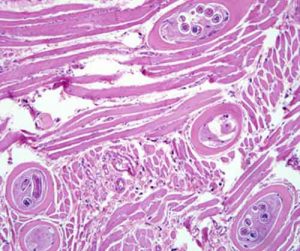
According to a release from the Center for Disease Control, Norton Sound was again struck by suspected Walrus-related Trichinellosis from eating under-cooked Walrus meat, bringing the outbreak to a total of ten since August of 2016.
The incidences this year and in 2016, mark the first time in 23 years that the parasite, from Walrus, has caused any reported illness. It was in 1992 that a Norton Sound man became ill from eating Walrus.
It was on August 31, of 2016, that a young girl went to the Gambell health clinic when she began having difficulty walking and reported weakness and fever. After discovering her swollen legs and rash, the young girl was referred to the Alaska Native Medical Center, and admitted there a week later.
The girl’s brother and father accompanied her to the Anchorage hospital. While there, they were evaluated and their blood tests came back positive for “eosinophilia, a commonly observed sign of parasitic infection; two patients also had elevated creatine kinase levels, indicative of muscle inflammation,” the CDC reported.
All three were treated for the parasite. Then a little over a week later, two more individuals from Gambell, the Aunt and Uncle of the stricken girl, reported similar symptoms, and were evaluated, and tested positive for “eosinophilia and elevated creatine kinase levels,” it was reported by CDC.
The two additional patients were also treated for the parasite, and all five recovered after treatment.
Then, on May 12th, another suspected case of walrus-related trichinellosis was reported from the community of Savoonga. He was transported to Norton Sound Regional Hospital, where he was evaluated after reporting symptoms consistent with trichinnellosis and found to have “eosinophilia and elevated creatine kinase levels.”
ADPH and the Nome Public Health Center staff members conducted interviews and identified another four cases from the shared meal. Two in the patients household, a sister and mother, and the patient’s hunting partner and his sister in a second household, were all tested and found to have elevated levels of creatine kinase and eosinophila. These four additional patients were treated and fully recovered as well.
Testing of 11 bags of unlabeled walrus meat would turn up one bag contaminated with the larva.
The CDC informs that “Trichinellosis is a parasitic disease that results from consumption of raw or under cooked meat infected by roundworm species in the genus Trichinella (5). Early signs and symptoms occur 1–2 days after ingestion and include diarrhea, abdominal pain, fatigue, nausea, and vomiting. Systemic signs and symptoms, which typically occur 1–2 weeks after ingestion and last for 1–8 weeks, include facial and periorbital edema, fatigue, fever (remittent) and chills, headache, muscle soreness, pruritus (with or without a rash), nausea, difficulty coordinating movement, neurologic complications, and cardiopulmonary impairment.”
While many who dine on Walrus meat, traditionally prefer that the meat not be well-done, it is advisable to fully cook the walrus meat in order to kill the parasite.
There have been 241 reported cases of trichinellosis in Alaska since 1975, of that 241, 227 of those cases were attributed to black, grizzly, and polar bear, and walrus and ice-associated seals.
